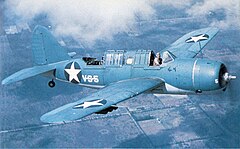Brewster SB2A Buccaneer
 Brewster SB2A Buccaneer | |
| Dane podstawowe | |
| Państwo | |
|---|---|
| Producent | Brewster Aeronautical Corporation |
| Typ | samolot zwiadowczo-bombowy |
| Załoga | 2 |
| Historia | |
| Data oblotu | 17 czerwca 1941 |
| Liczba egzemplarzy | 771 |
| Dane techniczne | |
| Napęd | 1× 8-cylindrowy Wright R-2600, 1,200 KM (895 kW) |
| Wymiary | |
| Rozpiętość | 14,33 m |
| Długość | 11,94 m |
| Wysokość | 4,70 m |
| Powierzchnia nośna | 35,2 m² |
| Masa | |
| Własna | 4501 kg |
| Startowa | 6481 kg |
| Osiągi | |
| Prędkość maks. | 441 km/h |
| Pułap | 7590 m |
| Zasięg | 2696 km |
| Dane operacyjne | |
| Użytkownicy | |
| Stany Zjednoczone, Wielka Brytania | |
| Rzuty | |
 | |
Brewster SB2A Buccaneer (ang. Bukanier) – dwumiejscowy samolot zwiadowczo-bombowy (SB – scout-bomber) zaprojektowany dla potrzeb amerykańskiej marynarki wojennej w latach 40. XX wieku. Został określony przez historyka Davida Donalda jako „najgorszy samolot II wojny światowej”[1].
Buccaneer był jednosilnikowym średniopłatem o klasycznej konstrukcji budowanym w trzech wersjach różniących się jedynie silnikiem. Wersja dla marynarki wojennej używała silnika Wright R-2600 o mocy 1200 KM (895 kW), budowano także dwie wersje dla US Army Air Corps (poprzednika USAF), wersja A-32 miała silnik Wright Cyclone 14, a odmiana A-32 otrzymała silnik Pratt & Whitney R-2800 "Double Wasp".
W ramach umowy Lend-Lease Act samoloty tego typu dostarczono także do Wielkiej Brytanii, gdzie znane były pod oznaczeniem Bermuda. „Bermudy” w RAF-ie wykorzystywano jako samoloty treningowe oraz do holowania celów powietrznych. Pięć egzemplarzy wyposażonych w silniki Cyclone zostało dostarczonych do brytyjskiego Fleet Air Arm w celach testowych.
Uzbrojenie
- 2× karabiny maszynowe 12,7 mm w kadłubie
- 2× karabiny maszynowe 7,62 mm w skrzydłach
- 2× karabiny maszynowe 7,62 mm strzelające do tyłu
- do 454 kg bomb


Przypisy
- ↑ David Donald: American Warplanes of World War II. Hoo: Grange Books, 2000, s. 37. ISBN 1-84013-392-9. (ang.)
Media użyte na tej stronie
US Flag with 48 stars. In use for 47 years from July 4, 1912, to July 3, 1959.
Roundel used by the United States armed forces from 19 August 1919 to 6 May 1942 until red dot removed to avoid confusion with Japanese insignia. Superseded very similar roundel whose colors and proportions differed slightly - the original version having the colors from the US flag, and a center dot 1/3 of the outer radius. This version has a center dot constrained by the inner vertices of the star, a size that does not translate into an even fraction.
Roundel used by US armed forces from 6 May 1942 to 28 June 1943 when white bars and a red outline were added as the result of studies which showed that shape was more important than color from a distance.
Autor: NiD.29, Licencja: CC-BY-SA-3.0
Roundel used by all US armed forces from 31 July 1943 to 14 January 1947, replacing roundel having red outline, or no outline, but with white bars, and was replaced some nine months before the USAF was formed, by roundel having a single lengthwise red bar inset in white bars (bisecting them), giving the insignia the trio of red-white-red stripes evocative of the non-canton areas of the Flag of the United States.
A U.S. Navy Brewster SB2A-4 Buccaneer in flight near Vero Beach, Florida (USA), in 1942-43.
Autor: Zala, Licencja: CC BY-SA 4.0
Amerykański 14-cylindrowy silnik gwiazdowy Wright Cyclone R-2600-23 z 1942 r. ze zbiorów Muzeum Lotnictwa Polskiego w Krakowie.
Original caption: "Aircraft. Naval. The Brewster "Buccaneer" (SB2A-1) is used by the Navy as scout dive bomber and escort plane. It is powered by a single-row Wright cyclone engine of 1,650 horsepower, has a top speed of about 350 miles per hour, a range of about 1,000 miles and a load capacity up to 11,000 pounds."
A Royal Air Force Brewster Bermuda I (s/n FF741), or Brewster A-34/Model B-340E.












